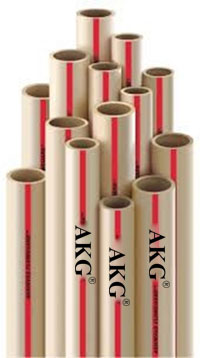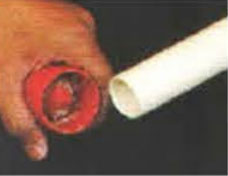- Plumbing : 0120-4619300-316/+91- 8448793165 |
- : plumbing@akggroupindia.com
- Electrical : 0120-2973710-713/+91- 9760148265 |
- : electrical@akggroupindia.com
A derivative of Polyvinyl Chloride (PVC), Chlorinated Polyvinyl Chloride (CPVC) is a thermoplastic produced by the chlorination of the PVC resin. AKG CPVC plumbing systems are manufactured using world's best Japanese material and Austrian technology & is a safe, long lasting and cost effective solution for hot and cold water. This system is suitable for all plumbing and potable water applications. The pipes and fittings are made of chlorinated polyvinyl chloride and it is available in complete range from 1/2" to 4". The pipes are available in SDR 11 and SDR 13.5 whereas fittings are available in SDR 11 pressure class. Threaded inserts in the transition fittings are made from brass to withstand chemical corrosion even at the elevated temperatures.
AKG CPVC Pipes and fittings are manufactured according to IS-15778 :2007 and ASTM D-2846 respectively. The choice of the raw material, the structural accuracy and the strict quality control imparts a high degree of reliability to AKG CPVC Pipes & Fittings making them most suitable, easy and economic solution for transportation and distribution of potable water. It has numerous advantages over G.I. and other conventional Piping system.

CPVC pipes as per IS 15778:2007 (SDR 11) |
|||||
| Size Inches | Size mm | Wall Thickness (mm) | OD (mm) | ||
| Min | Max | Min | Max | ||
| 1/2" | 15 | 1.7* | 2.2* | 15.8 | 16.0 |
| 3/4" | 20 | 2.0 | 2.5 | 22.1 | 22.3 |
| 1" | 25 | 2.6 | 3.1 | 28.5 | 28.7 |
| 1 -1/2" | 32 | 3.2 | 3.7 | 34.8 | 35.0 |
| 1 -1/2" | 40 | 3.8 | 4.3 | 41.2 | 41.4 |
| 2" | 50 | 4.9 | 5.5 | 53.9 | 54.1 |

CPVC pipes as per IS 15778:2007 (SDR 13.5) |
|||||
| Size Inches | Size mm | Wall Thickness (mm) | OD (mm) | ||
| Min | Max | Min | Max | ||
| 1/2" | 15 | 1.4* | 1.9* | 15.8 | 16.0 |
| 3/4" | 20 | 1.7 | 2.2 | 22.1 | 22.3 |
| 1" | 25 | 2.1 | 2.6 | 28.5 | 28.7 |
| 1 -1/2" | 32 | 2.6 | 3.1 | 34.8 | 35.0 |
| 1 -1/2" | 40 | 3.1 | 3.6 | 41.2 | 41.4 |
| 2" | 50 | 4.0 | 4.6 | 53.9 | 54.1 |
CPVC pipes as per ASTM F441 (SCH 40) |
|||||
| Size Inches | Size mm | Wall Thickness (mm) | OD (mm) | ||
| Min | Max | Min | Max | ||
| 2*1/2" | 65 | 5.16 | 5.77 | 72.82 | 73.18 |
| 3" | 80 | 5.49 | 6.17 | 88.70 | 89.10 |
| 4" | 100 | 6.02 | 6.73 | 114.07 | 114.53 |
CPVC pipes as per ASTM F441 (SCH 80) |
|||||
| Size Inches | Size mm | Wall Thickness (mm) | OD (mm) | ||
| Min | Max | Min | Max | ||
| 2*1/2" | 65 | 7.01 | 7.85 | 72.82 | 73.18 |
| 3" | 80 | 7.62 | 8.53 | 88.70 | 89.10 |
| 4" | 100 | 8.56 | 9.58 | 114.07 | 114.53 |


Important
Burrs, fillings & flares


| Fittings | Pipes | |
| Material | Chlorinated Polyvinyl Chloride (CPVC) |
Chlorinated Polyvinyl Chloride (CPVC) |
| Colour | Off- White | Off- White |
| Reference Standards | SDR-11 as per ASTM D2846 (Size 1/2" to 2") & Sch 80 as per ASTM F 439 (Size 2 1/2", 3" & 4") |
SDR-11 & 13.5 as per IS 15778:2007 (Size 1/2" to 4") & Sch 40 & Sch 80 as per ASTM F 441 (21/2", 3" & 4") |
| End Connections | Solvent sockets. For transition joints, fittings with plastic threaded & metal threaded inserts are available |
Solvent Joint |
© Copyright- AKG Group of Companies. All Rights Reserved. Powered By ITPL